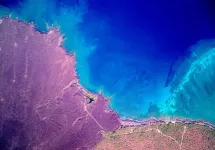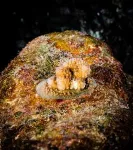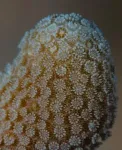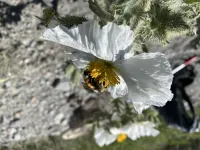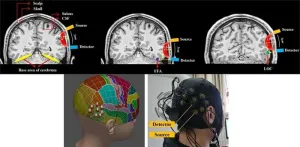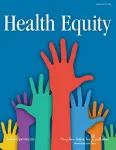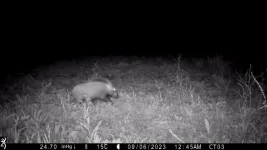(Press-News.org) When imagining corals, the picture that comes to mind is usually a stationary one: a garden of rock-like structures covering sections of the ocean floor. Reef conservation efforts typically focus on preserving established coral and protecting them from known stressors such as pollution, overfishing and runoff from coastline populations.
However, new research near Miloliʻi in the southwestern part of Hawai’i Island shows that identifying and protecting marine ecosystems, both down-current and up-current of coral reefs, specifically areas where coral larvae are more likely to survive and thrive, is crucial to future coral conservation and restoration efforts—especially as reefs face increasing pressure from the devastating effects of climate change.
The research, completed by Arizona State University scientists and their collaborators, appears in the current issue of Proceedings of the National Academy of Sciences.
Rachel Carlson, an ASU affiliate scientist and the study’s first author, along with Greg Asner, director of ASU's Center for Global Discovery and Conservation Science, and Robin Martin, associate professor with the ASU School of Ocean Futures in the Julie Ann Wrigley Global Futures Laboratory, and Larry Crowder, Professor of Oceans at Stanford University, collaborated on the project.
Additionally, the ʻĀkoʻakoʻa Reef Restoration Program, a regional effort that fuses cultural leadership, multi-modal education, advanced science and government engagement, backed the research.
Carlson says this type of collaborative work—partnerships combining local, indigenous knowledge and Western science – is crucial to mapping out a future that ensures the survival of coral populations.
“There’s a lot of indigenous knowledge about coral spawning and fish populations in West Hawaiʻi. In this study, we addressed an open question: how connected are coral populations between embayments along this coastline?” said Carlson. “What we essentially found is that the major factors in helping the coral keiki, known as larvae, settle down and survive are the nearshore current and the structure of the reef.”
The study shows that the larvae more often settle in and inhabit areas with large boulders and uneven surfaces, or “chunky features,” said Carlson, who is also a Chancellor's Postdoctoral Fellow at the UC Davis Bodega Marine Lab. Adult coral will spawn millions of larvae into the water column and those larvae prefer to settle in places with large knolls and boulders.
This discovery is good news: these kinds of seafloor features have been mapped via ASU’s Global Airborne Observatory, a highly specialized aircraft that uses several types of remote sensing technologies to track both underwater and land-based habitats. This means that the researchers have the capability to help find and map priority reefs for conservation and restoration.
“This is foundational research in several important ways,” said Asner, the study’s senior author. “First, it gives us an understanding of the connectivity of different parts of reefs along our coastline and tells us the level of connectivity in the context of the birth, settlement, and growth of corals miles apart. Second, our unique remote sensing capabilities can identify reef sites where coral restoration could be most viable in the future. Finally, these findings provide a critical building block for future restoration efforts by our ʻĀkoʻakoʻa team and collaborators.”
The group’s goal is to preserve and restore vitality to Hawaii’s coral reefs and coastline health.
"We as lineal descendants of the Miloliʻi area have always relied on the reef for our ʻOhana (families). Our reef is our sustenance and is of enormous cultural value to us." said Kaʻimi Kaupiko, president of the non-profit organization Kalanihale, which manages the Miloliʻi Community-based Subsistence Fishing Area (CBSFA) where the study took place.
Asner said the intertwined nature of reefs along Hawai‘i’s coastlines is crucial to consider in reef protection strategies. Narrowing in on one area without consideration for the reproductive corridors of corals, he said, would be akin to worrying about planting trees in a certain place and not thinking about the forest as a whole. This sentiment is echoed by Martin, who said reef connectivity is an underutilized tool in reef restoration efforts globally.
“In Hawai‘i and worldwide, we're trying to figure out where we should place protections and restore areas to help reefs,” Martin said. “This study is highly technical, but it needs to be part of that conversation and part of that work because if you aren’t protecting the up-current reefs, you are cutting off important reproductive areas.”
Martin said reef restoration could, for example, expand a protected area of reefs beyond just the spots that have more dense coral coverage on the ocean floor: protection efforts would also be needed in the upcurrent path that the coral larvae traveled through before they settled in a new location.
Asner adds that this research could very well help conservation efforts expand to much greater distances than have been achieved previously.
“These kinds of studies of connectivity, flow, and movement are needed because the west Hawaiʻi island coastline is longer than the whole circumference of any other island,” Asner said. “We have a lot of degraded reefs along our coastline, so knowing where and how to help baby corals thrive is fundamental to the ʻĀkoʻakoʻa restoration effort.”
"Our students participated in the coral study, and that also helped us to connect the dots between cultural knowledge and Western science,” said Kaupiko. “The study supports our CBSFA by showing that our area is ecologically connected, and thus it needs to be managed and protected as one connected reef and coastline."
Through the long-standing community collaborations that have shaped the ʻĀkoʻakoʻa program, this coral reef work reflects both cultural knowledge and scientific research. This type of approach is crucial in places like Hawai‘i, where a deep connection between coral reefs and people calls for research that serves them both.
By Sandra Leander and Kateyn Reinhart
END
Protecting coral ‘nurseries’ as important as safeguarding established coral reefs
New ASU research demonstrates miles-long connection between parent and baby corals
2024-01-08
ELSE PRESS RELEASES FROM THIS DATE:
Nutrition needs drive bee appetites
2024-01-08
FORT COLLINS, Colo., Jan. 8, 2024 — What’s all the buzz about? Most garden enthusiasts know that certain flowers can attract pollinators. New research helps explain why, and also provides more details about how the nutrition found in plant pollen may determine which specific bee communities might favor your garden. On a larger scale, this research may help fight against pollinator declines through better design of rangeland restoration projects.
Scientists at the USDA Forest Service’s ...
Using spectroscopy to measure visual recognition
2024-01-08
The brain is not only the most complex organ of the human body, but also one of the most difficult to study. To understand the roles of different regions of the human brain and how they interact, it is crucial to measure neuronal activity with awake subjects while they perform controlled tasks. However, the most accurate measurement devices are invasive, which greatly limits their use on healthy humans in real-life settings.
To overcome this major obstacle, scientists have come up with ingenious techniques to measure brain activity in safe and ...
New research aims to develop novel therapeutic for glaucoma
2024-01-08
INDIANAPOLIS—Researchers at Indiana University School of Medicine are using a novel approach to hopefully develop a new therapy for glaucoma, a complex disease that eventually leads to blindness, thanks to a new five-year, $2 million R01 grant from the National Eye Institute.
“Glaucoma is a silent, underdiagnosed, costly and debilitating disease,” said Tasneem Sharma, PhD, assistant professor of ophthalmology and lead investigator on the project. “It occurs when there is ...
Roundtable on efforts toward achieving health equity
2024-01-08
In the Roundtable titled “A Glimpse at How Stakeholders Are Working Towards Achieving Health Equity,” published in the peer-reviewed journal Health Equity, two expert panel discussions examine efforts to achieve maternal health equity and changes that health systems can make to operationalize health equity. Click here to read the Roundtable now.
The moderator of the panel discussion titled “Efforts to Achieve Maternal Health Equity Today” is Laurie Zephyrin, MD, MPH, MBA, Senior Vice President, Advancing Health Equity, The Commonwealth Fund. The discussion focuses on what health systems can ...
100 years of lifesaving work and counting: Happy Birthday to the American Heart Association
2024-01-08
Embargoed until 1 p.m. CT/2 p.m. ET Monday, Jan. 8, 2024
DALLAS, Jan. 8, 2024 — From humble beginnings as a small professional health society formed by six cardiologists in Chicago in 1924, the American Heart Association has emerged as the nation’s oldest and largest voluntary organization dedicated to fighting heart disease and stroke. Uniting more than 35 million volunteers and supporters and more than 2,900 employees, the Association today is a global force transforming the way the world understands, treats and prevents cardiovascular and cerebrovascular ...
Virginia Tech researchers find drugs used to treat Type 2 diabetes reduce alcohol cravings, use in individuals with obesity
2024-01-08
In social media posts on the community network Reddit, users reported reduced cravings for alcohol when taking drugs intended to treat Type 2 diabetes and obesity.
Across a number of threads — with titles such as “Did scientists accidentally invent an anti-addiction drug?” and “I don't know if this is a side effect but ... Mounjaro makes me drink less!!!!!” — users reported a changing relationship with beer, wine, and liquor.
An analysis of those posts, together with a remote study of individuals with obesity who reported using semaglutide ...
Rensselaer researcher helps scientists make sense of vast amounts of molecular data
2024-01-08
Thanks to technological advances, scientists have access to vast amounts of data, but in order to put it to work and draw conclusions, they need to be able to process it.
In research recently published in Genome Biology, Rensselaer Polytechnic Institute’s Boleslaw Szymanski, Ph.D., Claire and Roland Schmitt Distinguished Professor of Computer Science and director of the Network Science and Technology Center, and team have found a method that effectively organizes and groups the data for a variety of applications. The process is referred to as clustering ...
Solid state battery design charges in minutes, lasts for thousands of cycles
2024-01-08
Researchers from the Harvard John A. Paulson School of Engineering and Applied Sciences (SEAS) have developed a new lithium metal battery that can be charged and discharged at least 6,000 times — more than any other pouch battery cell — and can be recharged in a matter of minutes.
The research not only describes a new way to make solid state batteries with a lithium metal anode but also offers new understanding into the materials used for these potentially revolutionary batteries.
The research is published in Nature Materials.
“Lithium metal anode batteries are considered the holy grail ...
Andalibi to receive funding for Perthera Tissue Bank
2024-01-08
Andalibi To Receive Funding For Perthera Tissue Bank
Ali Andalibi, Senior Associate Dean, College of Science, is set to receive funding for: "Perthera Tissue Bank."
FFPE samples from Perthera will be housed in the cold room in the Institute for Advanced Biomedical Research (IABR). The Principal Investigator, Co-Investigator, and the staff member will be checking on the samples on a regular basis to ensure that the samples are safely stored and that the storage conditions, such as temperature, are appropriate. ...
How did the bushpig cross the strait? A great puzzle in African mammal biogeography solved by genomics
2024-01-08
In the ongoing biodiversity crisis, large terrestrial animals are more threatened by extinction than any other group of organisms. The African continent holds an impressively intact large-mammal community, but there is still a lot we do not know about how these species evolved, became diverse and adapted to the changing climate and habitats. Many of these questions can be addressed by investigating the genomes and genetic variation across species.
New research, published in Nature Communications, uses genomics to answer ...
LAST 30 PRESS RELEASES:
Numbers in our sights affect how we perceive space
SIMJ announces global collaborative book project in commemoration of its 75th anniversary
Air pollution exposure and birth weight
Obstructive sleep apnea risk and mental health conditions among older adults
How talking slows eye movements behind the wheel
The Ceramic Society of Japan’s Oxoate Ceramics Research Association launches new international book project
Heart-brain connection: international study reveals the role of the vagus nerve in keeping the heart young
Researchers identify Rb1 as a predictive biomarker for a new therapeutic strategy in some breast cancers
Survey reveals ethical gaps slowing AI adoption in pediatric surgery
Stimulant ADHD medications work differently than thought
AI overestimates how smart people are, according to HSE economists
HSE researchers create genome-wide map of quadruplexes
Scientists boost cell "powerhouses" to burn more calories
Automatic label checking: The missing step in making reliable medical AI
Low daily alcohol intake linked to 50% heightened mouth cancer risk in India
American Meteorological Society announces Rick Spinrad as 2026 President-Elect
Biomass-based carbon capture spotlighted in newly released global climate webinar recording
Illuminating invisible nano pollutants: advanced bioimaging tracks the full journey of emerging nanoscale contaminants in living systems
How does age affect recovery from spinal cord injury?
Novel AI tool offers prognosis for patients with head and neck cancer
Fathers’ microplastic exposure tied to their children’s metabolic problems
Research validates laboratory model for studying high-grade serous ovarian cancer
SIR 2026 delivers transformative breakthroughs in minimally invasive medicine to improve patient care
Stem Cell Reports most downloaded papers of 2025 highlight the breadth and impact of stem cell research
Oxford-led study estimates NHS spends around 3% of its primary and secondary care budget on the health impacts of heat and cold in England
A researcher’s long quest leads to a smart composite breakthrough
Urban wild bees act as “microbial sensors” of city health.
New study finds where you live affects recovery after a hip fracture
Forecasting the impact of fully automated vehicle adoption on US road traffic injuries
Alcohol-related hospitalizations from 2016 to 2022
[Press-News.org] Protecting coral ‘nurseries’ as important as safeguarding established coral reefsNew ASU research demonstrates miles-long connection between parent and baby corals
